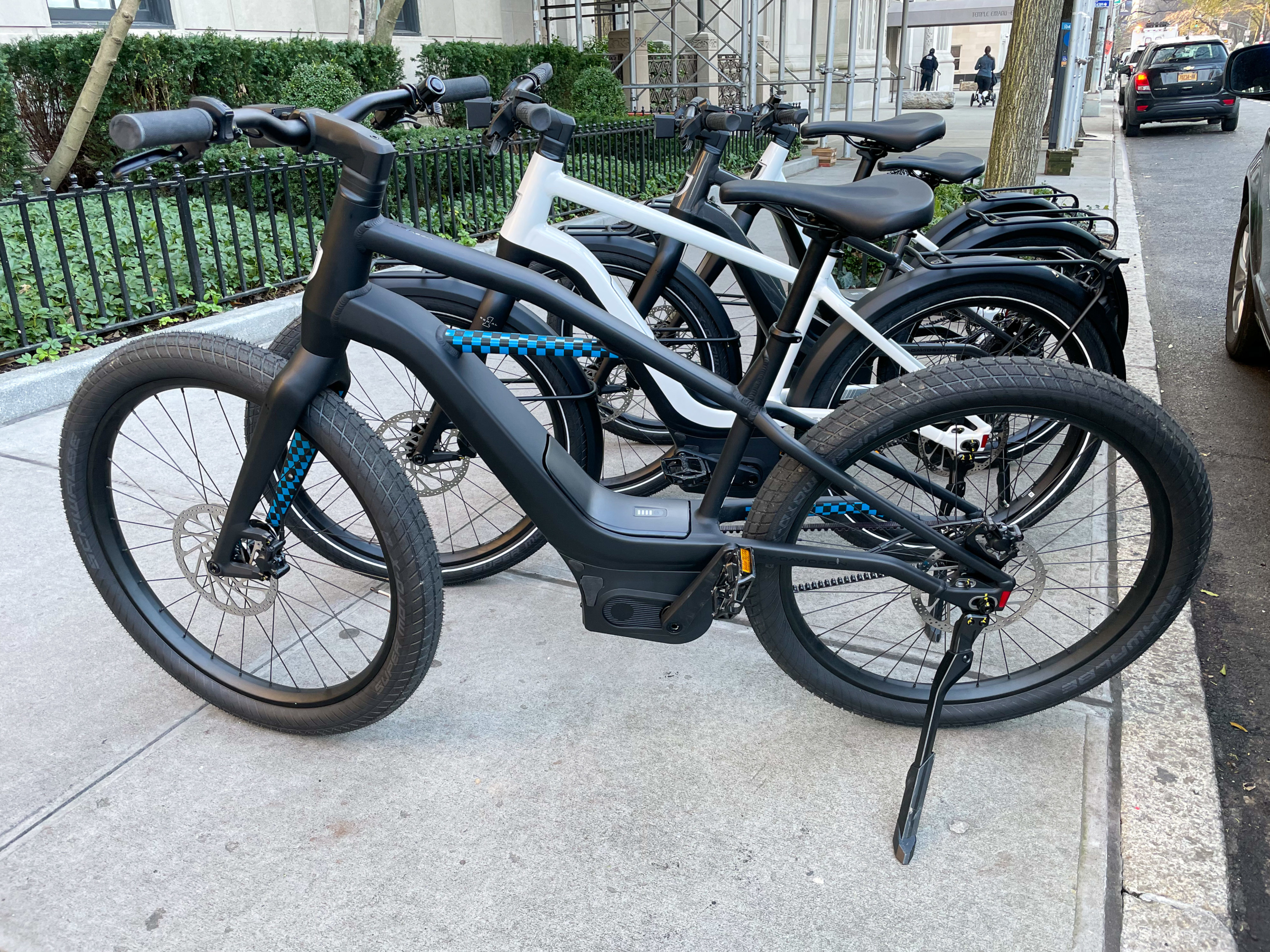We’ve all seen people riding e-bikes. And there’s even a good chance you’ve taken one for a spin, if you live in a city with a bikeshare program. Up until last week, that was my only exposure to e-bikes. I hadn’t ever been on a serious e-bike, nor had I really considered buying one or understood just how much they cost. Think used car money.
I had an opportunity to spend a morning riding two new e-bike models from Serial 1, a company backed by — and filled with talent from — Harley-Davidson. Now, I totally understand why someone would pay upwards of $5,000 for a bicycle.

Tearing up city streets
I started out on the most affordable, and simple, model: The MOSH/CTY (henceforth known as the Mosh). It immediately caught my eye with its sleek design and flat black paint. “Mosh” is a perfect name, because the bike is muscular and seems ready to tear up terrain. It has no fenders or fairings, and even its power controller is a simple set of LEDs rather than a screen. It’s about just hopping on and riding — and having blast doing so.
Ripping around the streets at 20 mph — without breaking a sweat — is addicting.
And I did. I immediately ripped around the streets of the Upper East Side and through Central Park, easily sweeping by other bikes in the bike lanes at a top speed of 20 mph. The Mosh really goads you into riding quickly and aggressively, because it only has one gear. And since it’s a pedal-assist bike, you only get power when you’re pedaling — so when you’re up above 15 mph, you really need to pedal aggressively to keep the motor moving and your speed constant.
You have four power modes — eco, tour, sport, and boost — that adjust the power provided relative to your pedaling. Boost is enough to have you beating cars off the line in city traffic without even standing up, but tour is plenty to help you keep up with other bikes or manage hills without much strain. I wouldn’t be surprised if the average Mosh rider stuck to “boost” 100% of the time, though; that power is addicting.
It’s downright fun, and you quickly start to enjoy the quirks of the powertrain. But because of this, the Mosh isn’t so much a commuter bike — it’s more of a $3,400 toy for shorter trips and occasional bouts with the dirt. It can tear up city terrain, but not for long rides — even though the charge range easily reaches 75 miles. The other Serial 1 I rode immediately after the Mosh is the exact opposite, and I loved it even more.

A speedy commute
The RUSH/CTY SPEED (We’ll refer to it as Rush Speed going forward) is a general-purpose, errand-running, commuter-focused bike, and it presents itself and rides exactly within those parameters. Narrower tires, full-length fenders, luggage racks, glossy paint, and a handlebar controller with a small screen all point to this bike’s purpose.
But here’s the thing: It has more speed, and more capability, than the Mosh. You get a top speed of 28 mph — the maximum allowed before this bike turns into a moped as far as government regulation is concerned. There’s a 33%-larger 706Wh battery to match. And here’s the tricky bit: There’s a CVT (continuously variable transmission) in the rear wheel hub. I loathe CVTs in cars, but the application is perfect here.
I’ll spare you the technical details, but basically, a CVT is a transmission that doesn’t have individual “gears,” yet it can still change an effective gear ratio using adjustable rollers. The Rush Speed’s CVT can provide anything from a 1:1 to 3:1-plus ratio, and it’s controlled electronically by an app on your phone. You set the ideal gearing for the amount of work you want to do and how fast you want to accelerate, and it intelligently adjusts depending on your speed mode and pedal power to keep you at the right gear ratio at all times.
The effect is wonderful. From a stop, you pedal very lightly, and the bike moves gently, but as you pick up a little speed, the motor assistance kicks in and the transmission changes to apply more of that power to the ground. The result is smooth and seamless acceleration, even up to a whopping 28 mph. And because the CVT can max out at a high ratio, you can actually cruise at 20-plus mph without a ton of pedaling, unlike on the Mosh. It also raises the effective power you’re getting out of each of the same four modes you’ll find on the Mosh.
The motor and gearing pair perfectly to provide acceleration and speed.
I was cruising past midday Manhattan car traffic, and beating everything in Central Park by several mph. Fully seated, with little effort, I cruised up the Queensboro Bridge at over 15 mph — and I’m not a small person. Turning around, and putting the 59-pound weight (10 pounds heavier than the Mosh) in motion, I was going 30 mph back down the span. Those are crazy numbers for an e-bike, and I can see exactly how someone could commute a good distance on this bike — all without breaking a sweat.
Depending on how much time you spend in “boost” mode and what your terrain is like, range can vary dramatically, from 25 to 115 miles. Real-world range with some spirited riding is probably going to be about 70 miles, meaning many people could get through a workweek from a charge. The battery is easily removable for charging if you don’t want to lug the whole bike up to an apartment. It goes from 0 to 75% in 3.5 hours and tops out at 100% in another three hours.
Attention to detail
No matter which model you choose, you’re getting the benefit of Serial 1’s great design. You can immediately tell these bikes were purpose-built from the ground up to be e-bikes based on the brilliant attention to detail. Unlike most cheap e-bikes, Serial 1s have a custom battery built into the lowest-possible point on the bike, down by the pedal assembly. That keeps the bikes stable at high speeds and in corners, which you notice right away. It’s also somewhat unique that the motor is placed in line with the pedal assembly, rather than out at the wheel hub, which again keeps weight in the right place and dramatically lowers the rotating mass of the wheels.
Now I understand why you’d spend $5,000 on an e-bike.
In addition to a high-quality motor, the bikes use a carbon fiber belt drive, which is quieter, cleaner, and maintenance-free. Every bit of cabling is routed through the frame, so nothing is loose or cluttered. There are sleek LED brake lights integrated into the back of the frame, and a powerful LED headlight on the front. (Plus, the Serial 1 badge at the top of the fork illuminates.) Absolutely nothing about the bikes shout “Harley-Davidson,” but you can tell that the folks at Serial 1 have the same mobility heritage and meticulous focus.
Serial 1 says that an overwhelming majority of its pre-orders have been for the top-spec Rush Speed model, which makes complete sense after riding it. The Mosh doesn’t necessarily have as much appeal, despite being cheaper, and the Rush Speed is just $500 more than the base Rush. You want that power and larger battery. The only reason to get a base Rush is to get the “step-through” model, which is easier to hop on and off of.

It’s not feasible for many people to even consider spending $3,400 on an e-bike, let alone $5,000. But for anyone who’s leaning toward having an e-bike as a primary means of transportation around a city, it’s worth looking at the considerable benefits of choosing one that’s built from the ground up to provide the best e-bike experience. Once you start comparing, looking at specs and features, you’ll find the Serial 1 is actually competitive. Sure, it’s the price of a used car, but that doesn’t mean it’s overpriced.





















